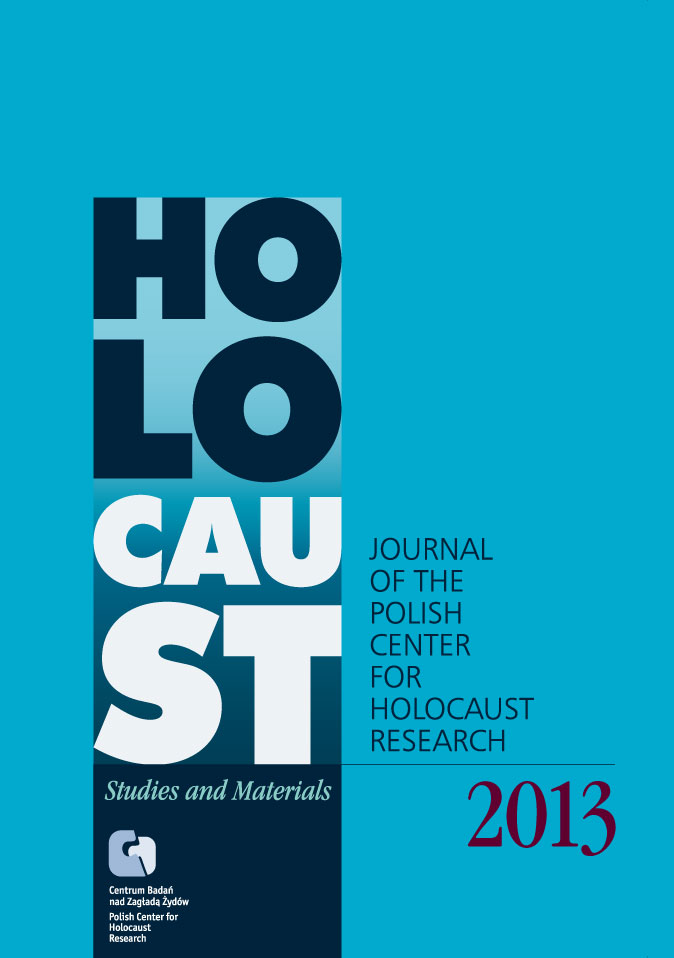Polish Help to Jews in the Countryside during the German Occupation. A Sketch Using the Example of the Righteous among the Nations
Zagłada Żydów. Studia i Materiały, Nr Holocaust Studies and Materials (2013), Strony: 122-158
Data zgłoszenia: 2020-12-13Data publikacji: 2013-02-20
 https://doi.org/10.32927/zzsim.797
https://doi.org/10.32927/zzsim.797
Abstrakt
The author analyzes help by Poles decorated with the Righteous among the Nations medal to Jews hiding in the countryside during the Nazi occupation. The author demonstrates that stories told many years later differ from immediate post-war recollections. A statistical analysis of the extensive material yields information on the various regularities related to help in rural areas: that the scale of help depends on the integration of the Jews with the Polish society, that they most often sought help close to their places of residence, that help came more frequently form the peasants than from the educated village dwellers, and that the greatest threat to the helpers were their own neighbors.
Licencja
Prawa autorskie (c) 2013 Autor & "Zagłada Żydów. Studia i Materiały"

Utwór dostępny jest na licencji Creative Commons Uznanie autorstwa 4.0 Międzynarodowe.
https://creativecommons.org/licenses/by/4.0
Inne teksty tego samego autora
- Zuzanna Schnepf-Kołacz, Losy pracowników niemieckiej gadzinówki „Nowy Kurier Warszawski” w świetle powojennych procesów z dekretu sierpniowego , Zagłada Żydów. Studia i Materiały: Nr 2 (2006)
- Zuzanna Schnepf-Kołacz, In a Ciechania presbytery The story of saving Zofia Trembska. A case study , Zagłada Żydów. Studia i Materiały: 2010: Holocaust Studies and Materials
- Zuzanna Schnepf-Kołacz, „Na ciechańskiej plebanii”. Historia ocalenia Zofii Trembskiej. Studium przypadku , Zagłada Żydów. Studia i Materiały: Nr 6 (2010)
- Zuzanna Schnepf-Kołacz, Włoski ogród historii. Rzym, Ferrara, Mediolan – nowe projekty na mapie żydowskich muzeów we Włoszech , Zagłada Żydów. Studia i Materiały: Nr 9 (2013)
- Zuzanna Schnepf-Kołacz, „Write your story” – seria wydawnicza Makor Jewish Community Library , Zagłada Żydów. Studia i Materiały: Nr 3 (2007)
Podobne artykuły
- Andrzej Leder, Kraina obłudy i święty gniew. O książce Przemoc filosemicka? Nowe polskie narracje o Żydach po roku 2000 , Zagłada Żydów. Studia i Materiały: Nr 13 (2017)
- Sławomir Buryła, Jerzy Jurandot, Miasto skazanych. 2 lata w warszawskim getcie, Stefania Grodzieńska, Dzieci getta , Zagłada Żydów. Studia i Materiały: Nr 12 (2016)
- Tomasz Żukowski, Jan Borowicz, Nagość i mundur. Ciało w filmie Trzeciej Rzeszy , Zagłada Żydów. Studia i Materiały: Nr 12 (2016)
- Aleksandra Ubertowska, Krzepiąca moc kiczu. Literatura Holokaustu na (estetycznych) manowcach , Zagłada Żydów. Studia i Materiały: Nr 6 (2010)
- Bartłomiej Krupa, Mietek Pachter, „Umierać też trzeba umieć” , Zagłada Żydów. Studia i Materiały: Nr 12 (2016)
- Jurij Radchenko, Popularnonaukowa propaganda i „walka z mitami”: stosunki ukraińsko-żydowskie w XX w. w tekstach Wołodymyra Wjatrowycza , Zagłada Żydów. Studia i Materiały: Nr 12 (2016)
- Magdalena Bogusławska, Zagłada Żydów w serbskim porządku pamięci , Zagłada Żydów. Studia i Materiały: Nr 12 (2016)
- Jacek Dehnel, Wszystkie procesy Eleazara Grünbauma , Zagłada Żydów. Studia i Materiały: Nr 12 (2016)
- Jan H. Issinger, Frankenstein w warszawskim getcie. Historia i legenda , Zagłada Żydów. Studia i Materiały: Nr 12 (2016)
- Arkadiusz Morawiec, Lagry w perspektywie genderowej , Zagłada Żydów. Studia i Materiały: Nr 6 (2010)
<< < 53 54 55 56 57 58 59 60 61 62 63 64 65 66 67 68 69 70 71 72 73 74 75 76 77 78 79 80 > >>
Możesz również Rozpocznij zaawansowane wyszukiwanie podobieństw dla tego artykułu.
 English
English
 Język Polski
Język Polski








